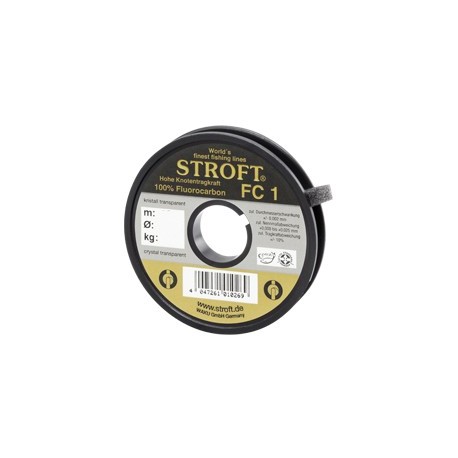No products
 View larger
View larger Stroft Fluorocarbon FC1
New product
STROFT FC1 is the fishing line that came up with the highest breaking strain ever achieved with 100% fluorocarbon. Particular focus is laid on the line’s knot strength which is fine tuned for each individual diameter.
28 Items
- Write a review
More info
STROFT FC1 is the fishing line that came up with the highest breaking strain ever achieved with 100% fluorocarbon. Particular focus is laid on the line’s knot strength which is fine tuned for each individual diameter. Because of that highly crucial characteristic and its other significant benefits – abrasion resistance, faster sink rate, minimal tensile elongation, strike elongation, casting performance, longevity, low visibility (see page 13) – STROFT FC1 is a perfect piece of kit for all forms of leaders/ tippets. Speaking of characteristics, a distinguishing feature between fluorocarbon and monofilament lines which is often hotly debated in the angling press is the difference in elongation. Or more precisely the different rates of the elongation properties under different line load (see diagram page 10 – elongation properties).
Looking at the blue graph for monofilaments such as GTM and ABR one will notice an undulated line, whereas the black dotted line for fluorocarbon FC1 and FC2 is a straight line, which crosses the blue graph at a line load of 50%. In other words in high line load situations FC stretch more than GTM and ABR, while the elongation in both types of line, are comparable for the strike range (approx. 50 % line load) . In the range of minimal line load FC show lower stretch than GTM and ABR, which translates to higher sensibility, better line feedback and bite detection. Characteristics that anglers experience when on the water. If anglers look for these latter qualities FC1 and FC2 are their first choice. For the relative high price of FC1 we do recommend anglers use FC2 as their leader material and select FC1 as a tippet. This serves the same purpose at the fraction of the cost.
Color: Crystal transparent
About monofilament made of Fluorocarbon
Fluorocarbon is the name of the second basic material that has been used in the manufacture of monofilament fishing lines since 1972. The chemical name is Polyvinylidenfluorid (abbreviation: PVDF). Other trade names are “Kynar“, “Dyneon“ and “Solef”. The euphoria that heralded the use of these products for fishing lines was quickly followed by the sobering facts that although this material does have advantages the disadvantages are indeed great. One simply had not weighed the advantages against the disadvantages. The knot strength was found to be very critical. So initially the field of application was pretty much limited, nevertheless the line had its advantages in certain fishing situations.
And in recent years it has been possible to improve the knot strength remarkably! The STROFT lines that are made of 100% Fluorocarbon are called STROFT FC1 and STROFT FC2, and are featuring outstanding breaking strain. At the same time the breaking strain of STROFT FC2 is only slightly less in comparison to STROFT FC1. And in global comparing the knot breaking strain of Fluorocarbon lines, STROFT FC1 is ahead by a nose. To achieve this the STROFT FC1 has to undergo a very costly additional tuning process - and this makes the actual difference between FC1 and FC2, which of course is somewhat reflected in the price.
For this reason STROFT FC 1 is excellent for traces and STROFT FC2 can also be used as a main line. We paid particular attention to the sensitivity and feed-back as well as the resistance to abrasion of both lines. Peak performance can be expected in both these properties; even though the lines cannot be classed as particularly hard, they have low elasticity and are best described as being supple and tough. These new lines have a comparatively low memory, certainly in comparison to other fluorocarbon lines, and the thinner lines also cast well from a fixed spool reel.
For further general information regarding fluorocarbon lines please see www.stroft.de -> FAQs -> What are the pros and contras of Polyamide, Fluorocarbon and UHMWPE.
The following excerpts point out the main features and differences between STROFT FC lines compared to STROFT lines made of Polyamide alloy:
- Abrasion-resistance: Very high resistance to abrasion with low rate of absorption (water absorption 0.01%); this value stays constant even after being immersed for several hours, which makes this the ideal material for use on rocky ground or mussel beds.
- Density: Fluorocarbon is heavier (1.78 g/cm3 as opposed to Polyamid 1.14 g/cm3 ), so it tends to sink. That makes it ideal, if one requires a strong line that sinks quickly.
- Sensitivity: Extreme sensitivity as a result of the minimal load- longation makes the line particularly useful whenever lure feedback and bite detection are paramount (spinners, spoons). The relatively high specific weight of the line results in the line straightening quickly after casting and improves bait contact.
- Casting (fly fishing): The higher specific weight also helps the leader ”role out“ nicely on the cast when the tip is made of Fluorocarbon as well as helping both nymph and streamer presentation.
- Durability: Very high durability as UV-light, saltwater and other aggressive substances have practically no effect. Ideal for sea fishing and wherever high levels of solar radiation are expected.
Visibility: The refractive index of fluorocarbon is 1.42 as opposed to 1.58 for Polyamide; as a result it’s closer to that of water, which is 1.33. For this reason, it is less visible to the human eye when immersed in clear water.
Tip:
In order to utilize the higher linear breaking strain of STROFT FC pay particular attention to knots and connections. Depending on how you are fishing, use rig rings (see page 27) or snap swivels when attaching the last, thinnest section of trace line. This achieves better knot strengths than blood-knots or double grinners.


